Schools Using Solar Power
Implementing
Solar Power
"Wow! That is so cool!"
"What happens if I do this?"
By Sondra Hines � Community Works
During the week of July 15, a group of children ranging in age from 6 to 12 gathered
under the Big Yellow Tent next to the Great Northern Carousel in Helena to explore
renewable energy.
Most of our week was devoted to
the power of the sun and solar energy. We began our exploration by building solar
ovens out of pizza boxes, which we then used all week for cooking various delectable
treats, such as hot dogs, s�mores, and quesadillas. We also tried to answer the
age-old question: "Can you fry an egg on the sidewalk?" We tried various
methods for getting those eggs to cook from putting them directly on the concrete
to placing them under glass in a cast iron skillet. I�m sad to say we were not
successful. We had a great time, but there were no eggs to be eaten.
Tim Ranf of Pioneer Technical Service
in Helena assisted throughout the week and created a large solar cooker that we
used for making chocolate chip cookies.
We were excited to meet Ray Schott,
educator for the National Center for Appropriate Technology. Ray spent one morning
with us explaining how the sun can make electricity. We dramatized the process,
which really helped bring the magic to life and bring understanding to us all.
We set up a solar-powered water fountain loaned to us from Chris Borton at Sage
Mountain Center as well as a solar fan loaned from Tony Boniface of Independent
Power Systems. The kids were fascinated by the fact that they could affect the
flow of water by shadowing the photovoltaic panel in some way. Ray showed us how
to use a voltmeter to see if electricity was flowing. He also assisted the kids
in hooking up their own photovoltaic (PV) cell to a small DC motor. The group
spent over an hour making fans and other spinning creations with their systems.
The big project of the week involved
building solar vehicles out of plastic, wood, rubber bands, dc motors and PV cells.
This was a fun and challenging project � one that everyone succeeded in. The group
gained first-hand knowledge about maintaining good wire connections, construction
and design stability, PV cell placement for most efficient performance and other
variables that might increase or decrease performance. We found that PV cells
don�t work as well if they get too hot and that a bigger DC motor would speed
up our time trials a bit.
After constructing a darkroom out
of cardboard and duct tape, participants made cyanotypes. Cyanotypes are blueprint
photographs made using light sensitive fabric and the power of the sun. This is
a truly magical activity as the images appear before your very eyes while the
fabric is exposed to sunlight.
In extending our exploration of
the sun�s power, we learned that it is also responsible for the winds that blow,
the coal and other fossil fuels we burn, AND the rain that falls, which all contribute
to the energy we use in our daily lives.
The group then went on to explore
another form of renewable energy by focusing on wind. We learned about wind turbines
and wind anemometers from Mark Hines, an energy engineer for the Montana Department
of Environmental Quality. We then made our own anemometers that illustrated to
us in a simple way the speed of the wind. We built wind turbines out of straws,
dowels, cork, wooden beads and paper that could do work such as lifting a small
plastic toy using only the power of the wind.
The participants were turned on
by the possibilities of renewable energy and anxious to experience more. We hope
to be able to offer many exciting opportunities such as this and more through
the Museum of Exploration and Discovery now being developed in Helena.
Thanks to all who participated
and assisted in making the camp a success and to NCAT for loaning us Ray and sharing
our work on their website.
Camp Photos

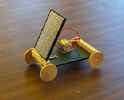
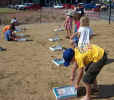
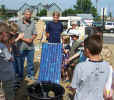



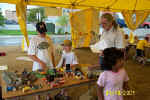

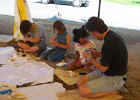
Energy
Smart Schools
A project of the U.S. Department of Energy's Rebuild America Project, Energy Smart
Schools focuses on helping schools use energy more wisely. Website includes links
to teaching resources, success stories, news and events, and more.
Solar
Matters I, II, and III
These three online solar energy science units, developed by the Florida Solar Energy
Center, are intended to help students in grades K-2, 3-5, and 6-8 learn about solar energy
through a variety of activities.
Schools
Going Solar
Did you know that many schools across the country are equipped with solar energy
systems that not only provide solar electricity, hot water, good quality lighting
and other benefits to the school building, but also help students augment their
math and science studies, and even help them stay healthier and earn better grades
overall? Visit the
Schools Going Solar website operated by Interstate Renewable Energy Council.
The site features a comprehensive list
of links and on-line real-time data for solar schools. You
can also read the project's monthly newsletter and find more resources on solar
schools.
Watts
on Schools
A project of three electric utilities, Watts on Schools is installing solar systems
on schools in Texas, Arkansas, and Louisiana. Website provides information on
the host schools, equipment, education activities, and more.
|